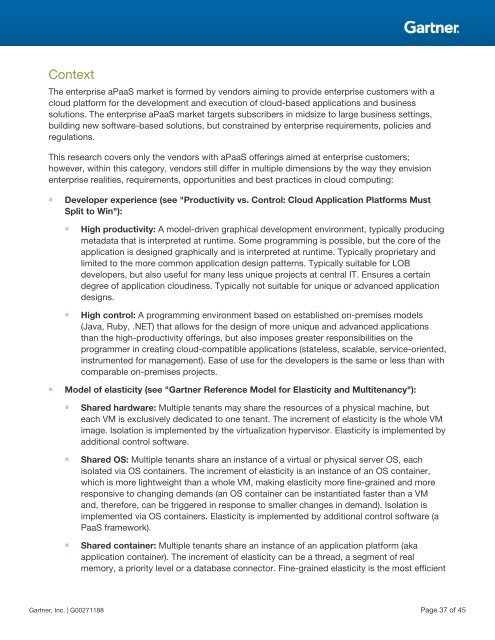Magic Quadrant for Enterprise Application Platform as a Service, Worldwide
Create successful ePaper yourself
Turn your PDF publications into a flip-book with our unique Google optimized e-Paper software.
Context<br />
The enterprise aPaaS market is <strong>for</strong>med by vendors aiming to provide enterprise customers with a<br />
cloud plat<strong>for</strong>m <strong>for</strong> the development and execution of cloud-b<strong>as</strong>ed applications and business<br />
solutions. The enterprise aPaaS market targets subscribers in midsize to large business settings,<br />
building new software-b<strong>as</strong>ed solutions, but constrained by enterprise requirements, policies and<br />
regulations.<br />
This research covers only the vendors with aPaaS offerings aimed at enterprise customers;<br />
however, within this category, vendors still differ in multiple dimensions by the way they envision<br />
enterprise realities, requirements, opportunities and best practices in cloud computing:<br />
■<br />
Developer experience (see "Productivity vs. Control: Cloud <strong>Application</strong> Plat<strong>for</strong>ms Must<br />
Split to Win"):<br />
■<br />
■<br />
High productivity: A model-driven graphical development environment, typically producing<br />
metadata that is interpreted at runtime. Some programming is possible, but the core of the<br />
application is designed graphically and is interpreted at runtime. Typically proprietary and<br />
limited to the more common application design patterns. Typically suitable <strong>for</strong> LOB<br />
developers, but also useful <strong>for</strong> many less unique projects at central IT. Ensures a certain<br />
degree of application cloudiness. Typically not suitable <strong>for</strong> unique or advanced application<br />
designs.<br />
High control: A programming environment b<strong>as</strong>ed on established on-premises models<br />
(Java, Ruby, .NET) that allows <strong>for</strong> the design of more unique and advanced applications<br />
than the high-productivity offerings, but also imposes greater responsibilities on the<br />
programmer in creating cloud-compatible applications (stateless, scalable, service-oriented,<br />
instrumented <strong>for</strong> management). E<strong>as</strong>e of use <strong>for</strong> the developers is the same or less than with<br />
comparable on-premises projects.<br />
■<br />
Model of el<strong>as</strong>ticity (see "Gartner Reference Model <strong>for</strong> El<strong>as</strong>ticity and Multitenancy"):<br />
■<br />
■<br />
■<br />
Shared hardware: Multiple tenants may share the resources of a physical machine, but<br />
each VM is exclusively dedicated to one tenant. The increment of el<strong>as</strong>ticity is the whole VM<br />
image. Isolation is implemented by the virtualization hypervisor. El<strong>as</strong>ticity is implemented by<br />
additional control software.<br />
Shared OS: Multiple tenants share an instance of a virtual or physical server OS, each<br />
isolated via OS containers. The increment of el<strong>as</strong>ticity is an instance of an OS container,<br />
which is more lightweight than a whole VM, making el<strong>as</strong>ticity more fine-grained and more<br />
responsive to changing demands (an OS container can be instantiated f<strong>as</strong>ter than a VM<br />
and, there<strong>for</strong>e, can be triggered in response to smaller changes in demand). Isolation is<br />
implemented via OS containers. El<strong>as</strong>ticity is implemented by additional control software (a<br />
PaaS framework).<br />
Shared container: Multiple tenants share an instance of an application plat<strong>for</strong>m (aka<br />
application container). The increment of el<strong>as</strong>ticity can be a thread, a segment of real<br />
memory, a priority level or a datab<strong>as</strong>e connector. Fine-grained el<strong>as</strong>ticity is the most efficient<br />
Gartner, Inc. | G00271188 Page 37 of 45



